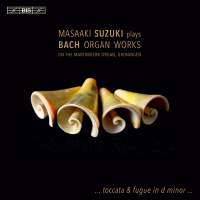Texte paru dans: / Appeared in: |
|
|
Outil de traduction ~ (Très approximatif) |
|
|
Reviewer: Jerry
Dubins If this is the first volume in a projected survey of Bach’s complete organ works by Masaaki Suzuki—and I suspect it is—then it appears that the keyboardist and conductor of the Bach Collegium Japan is pursuing his mission to record very nearly everything Bach wrote. Suzuki launches this first volume with what is virtually de rigueur for any kickoff to a Bach organ cycle, the Toccata and Fugue in D Minor, BWV 565, a virtuoso showpiece that most likely dates to around 1708 during the young composer’s years in Weimar. Next on the program come two perhaps somewhat less familiar works, the Pastorale in F Major and Partite diverse sopra il Corale: O Gott, du frommer Gott. The Pastorale of the title applies only to the first movement or section of this four-part work, which is followed by an allemande, an aria, and a closing gigue. The Partite diverse sopra il Corale, as its title tells us, is a set of variations on a chorale tune, this one being a well-known chorale of the time O Gott, du frommer Gott, on verses by Johann Heermann. Continuing on, Suzuki returns to Bach’s non-liturgically based, virtuosic display pieces to give us the G-Major Fantasia, BWV 572, and the Prelude and Fugue in G Minor, BWV 535. Both of these works also date from the composer’s Weimar period. The Prelude and Fugue is an especially early piece, written no later than, and possibly earlier than, 1703, when Bach would have been no older than 18. The G-Major Fantasia is believed to have been written a bit later, perhaps in 1712, at a time when Bach journeyed to Arnstadt and Mühlhausen to play on some of the great organs there. The Canonic Variations of 1747 is a very late work, dating to around the same time Bach was working on A Musical Offering and The Art of Fugue, and the piece exhibits much the same preoccupation with complex contrapuntal procedures. Suzuki concludes his program with the Prelude and Fugue in E Minor, BWV 548. Curiously, the detailed and informative booklet note authored by Albert Clement fails to mention that this is the fugue that has earned the popular nickname, “The Wedge,” due to its subject which begins with a single note, adds two notes to either side of it, forming a minor third, and then gradually widens its compass to an octave. The exact date of composition is not known, but it’s believed to be sometime between 1727 and 1731, which would place Bach in Leipzig at the time. For this recording Suzuki has chosen the Schnitger/Hinz organ in Groningen’s Martinikerk (Martin’s Church), one of the Netherlands’ most impressive and important organs. It’s an instrument that has been played by a number of famous organists, including Marie-Claire Alain, Ton Koopman, and Gustav Leonhardt. Originally dating back to the 15th century, the organ has been several times restored and upgraded. Today, it boasts three manuals plus pedal and a total of 52 stops, and it’s tuned to a pitch of A=465 Hz. I very much like Suzuki’s way with these works. His choice of stops and registrations is always imaginative but appropriate to the music, and he brings fresh interpretive ideas to a familiar piece such as the D-Minor Prelude and Fugue, informed, no doubt, by his immersion in period performance practice in general and Bach’s music in particular. The organ makes for a commanding presence, and BIS’s sound is equally imposing.
My one and only problem with
this release is related to something beyond Suzuki’s and possibly the
recording engineer’s ability to tame or control, and that is the long reverb
period and extremely cavernous sound of Martin’s Church. It is unhelpful in
clarifying and distinguishing Bach’s contrapuntal lines, especially in
faster movements, where the waves of outgoing sound are overtaken and
swallowed up by the waves washing back in. This is not an ideal acoustic for
Bach’s organ music, but many churches, unfortunately, suffer from this
phenomenon, and that’s where so many of the world’s great organs happen to
live. | |
|
|
|
|
Cliquez l'un ou l'autre
bouton pour découvrir bien d'autres critiques de CD |
|




